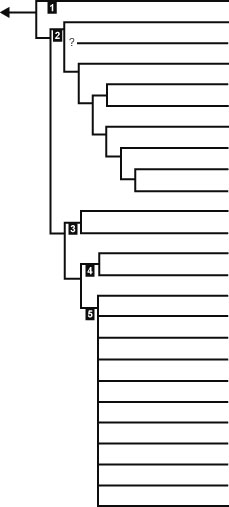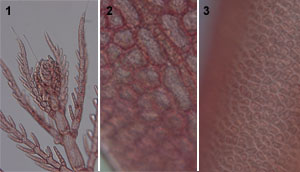| NIES-MCC | KU-MACC | Tree to Strain | Japanese | English |
| Life / Eukarya / Plantae / Rhodophyta / Florideophyceae | |

|
Hildenbrandiales (Hildenbrandia etc.) Batrachospermales (Batrachospermum, Lemanea etc.) Rhodachlyales (Rhodachlya) Thoreales (Nemalionopsis, Thorea etc.) Balliales (Ballia) Balbianiales (Balbiania etc.) Nemaliales (Liagora, Nemalion, Helminthocladia, Scinaia, Galaxaura, Dermonema etc.) Colaconematales (Colaconema etc.) Acrochaetiales (Acrochaetium etc.) Palmariales (dulse, Halosaccion etc.) Rhodogorgonales (Rhodogorgon etc.) Corallinales (coralline algae etc.) Ahnfeltiales (Ahnfeltia etc.) Pihiellales (Pihiella) Acrosymphytales (Acrosymphyton etc.) Bonnemaisoniales (Asparagopsis, Bonnemaisonia, Delisea etc.) Gigartinales (Neodilsea, Gloiopeltis, Chondrus, Mastocarpus, Hypnea, Meristotheca etc.) Gelidiales (Gelidium, Pterocladiella, Acanthopeltis etc.) Gracilariales (Gracilaria etc.) Halymeniales (Carpopeltis, Grateloupia, Cryptonemia, Halymenia, Prionitis etc.) Rhodymeniales (Champia, Fauchea, Lomentaria, Coelarthrum etc.) Sebdeniales (Sebdenia, Crassitegula, Lesleigha etc.) Nemastomatales (Nemastoma, Predea, Tsengia, Schizymenia, Platoma etc.) Plocamiales (Plocamium, Sarcodia etc.) Ceramiales (Ceramium, Chondria, Dasya, Griffithsia, Delesseria, Polysiphonia, Laurencia etc.) |
|
1. Hildenbrandiophycidae 2. Nemaliophycidae 3. Corallinophycidae 4. Ahnfeltiophycidae 5. Rhodymeniophycidae |
|
| References |
|
|
Multicellular red algae mostly living in coastal water. Some species (Batrachospermum, Thorea etc.) inhabit in freshwater. Some florideophycean algae such as Gelidium, Gracilaria, Palmaria are used as food or source of agar and carrageenans. Thalli usually with apical growth by single (monoaxial type) or many (multiaxial type) apicall cells. Tissue is pseudoparenchymatous. Main component of the cell wall is cellulose or β1,3-xylan. All corallinalean algae and some species of the Nemaliales and Ceramiales deposit calcium carbonate on cell wall. Florideophycean algae possess the pit connection, in which the pit plug is sometimes covered by cap membrane. Multinuclear cells frequently occur. There are many parasitic species involved with cell fusion to host cell (usually adelphoparasites). Cells usually possess many chloroplasts, but some species have a single stellate chloroplast. Most remarkable feature of the Florideophyceae is a unique triphasic alternation of generations in life cycle. Fertilized carpogonium (= egg cell) on gametophyte directly or indirectly develops into a carposporophyte. The carposporophyte produces diploid carpospores that develop into the diploid tetrasporophytes. The tetrasporophyte produces haploid tetraspores via meiosis, and the tetraspore develops into haploid gametophyte. The gametophyte and tetrasporophyte are isomorphic (Polysiphonia-type) or heteromorphic (Bonnemaisonia-type, Batrachospermum-type). |
 1: AntithamnioniCeramiales, KU-1001). 2: DelesseriaiCeramiales, KU-971). 3: GelidiumiGelidiales, KU-1001). |